
views
MLA
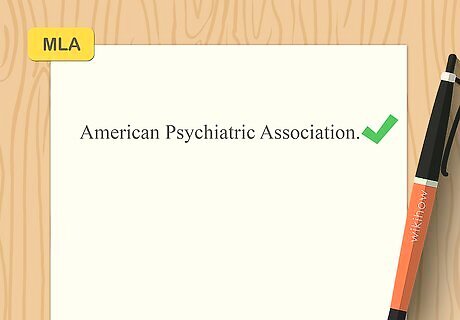
Start with the association if citing the database. If you accessed the DSM-V through the online database, start with the name of the American Psychiatric Association as the author of the manual. Follow the association's name with a period. Example: American Psychiatric Association.
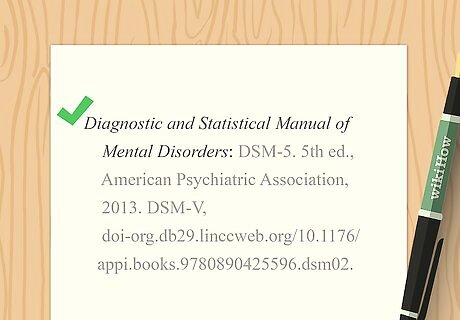
Put the title of the manual first if citing the book. If you used the book version of the DSM-V rather than the database version, your bibliographic citation will look slightly different. Instead of starting with the name of the APA, you'll start with the title of the manual in italics. Follow the full name with the abbreviation "DSM-5." Example: Diagnostic and Statistical Manual of Mental Disorders: DSM-5. 5th ed., American Psychiatric Association, 2013. DSM-V, doi-org.db29.linccweb.org/10.1176/ appi.books.9780890425596.dsm02.
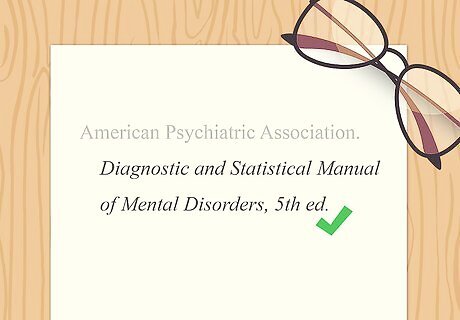
Include the title of the manual in italics, followed by the edition. Spell out the full name of the manual, followed by a comma. Then identify that you're referencing the fifth edition of the manual by typing "5th ed," followed by a period. Example: American Psychiatric Association. Diagnostic and Statistical Manual of Mental Disorders, 5th ed.
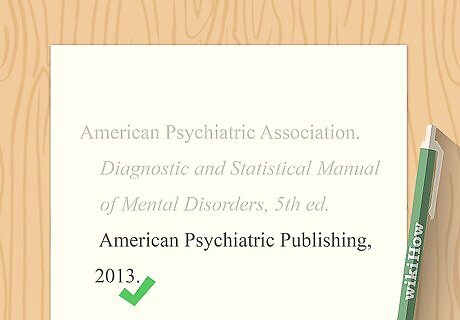
Provide the name of the publisher and the date of publication. For the DSM-V, the name of the publisher is "American Psychiatric Publishing." Don't repeat the name of the association. Place a comma after the name of the publisher, followed by 2013, the year of publication. Place a period after the year of publication. Example: American Psychiatric Association. Diagnostic and Statistical Manual of Mental Disorders, 5th ed. American Psychiatric Publishing, 2013.
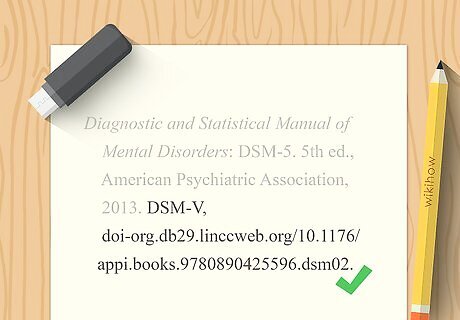
List the database along with a permalink to the manual itself. After the year of publication, type "DSM-V" as the database, followed by a comma. The name of the database should be in italics. After the comma, include a direct permalink to the DSM-V's location within the database. Example: American Psychiatric Association. Diagnostic and Statistical Manual of Mental Disorders, 5th ed. American Psychiatric Publishing, 2013. Do not include the "http://" portion of the URL at the beginning of the permalink.

Add the date accessed, if required. For the DSM-V, the date accessed is not typically required. The contents of the manual don't change unless a new edition is published. However, some instructors or supervisors may require it. If you include the date, use day-month-year format. Example: American Psychiatric Association. Diagnostic and Statistical Manual of Mental Disorders, 5th ed. American Psychiatric Publishing, 2013. Accessed 15 August 2018.

Include the association's name in your text where possible. For in-text parenthetical citations, you would generally include the author and the page number. With the DSM-V, the author is the American Psychiatric Association. If you mention the association in your text, you only have to include the page number in your parenthetical. Example: According to the American Psychiatric Association, 3-7% of school-aged children have ADHD (12). Alternate example: Anywhere from 3 to 7 percent of school-aged children have ADHD (American Psychiatric Association 12).
APA

Start with the name of the association as the author. The American Psychiatric Association is both the credited author of the DSM-V and the publisher. Begin your bibliographic entry with the name of the association, followed by a period. Example: American Psychiatric Association.

Provide the year of publication in parentheses. Type a space after the period that follows the name of the author, then type the year 2013 in parentheses. This is the year of publication for the DSM-V. Place a period immediately after the closing parentheses. Example: American Psychiatric Association. (2013).
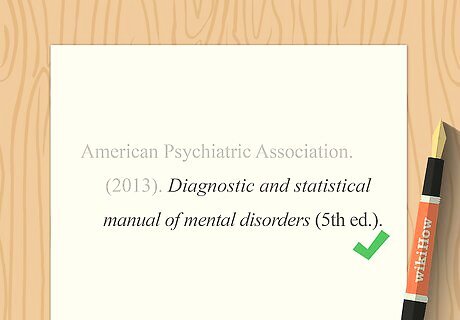
Type the title of the manual in italics. The title of the manual follows the year of publication as the next element of your bibliographic citation. Use sentence-case, capitalizing only the first word of the title. Follow the title with the edition number in parentheses. Do not italicize the edition number. Place a period immediately after the closing parentheses. Example: American Psychiatric Association. (2013). Diagnostic and statistical manual of mental disorders (5th ed.).

Close your citation with publication information. The final part of your bibliographic citation lists the location of the publisher along with the name of the publisher. Since the publisher of the DSM-V is the same as the author, simply use the word "Author" rather than repeating the name of the association. Example: American Psychiatric Association. (2013). Diagnostic and statistical manual of mental disorders (5th ed.).

Reference the DSM-V in text with a parenthetical. The APA uses author-date parenthetical citations to cite references in the text of your paper. In the case of the DSM-V, simply use the name of the association followed by a comma, then the year the 5th edition was published. Example: (American Psychiatric Association, 2013)
AMA
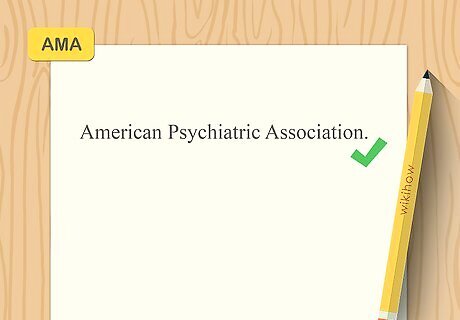
Start with the name of the author. For the DSM-V, the American Psychiatric Association is considered the author of the manual. In the AMA citation style, the author is listed first in bibliographic citations, followed by a period. Example: American Psychiatric Association.
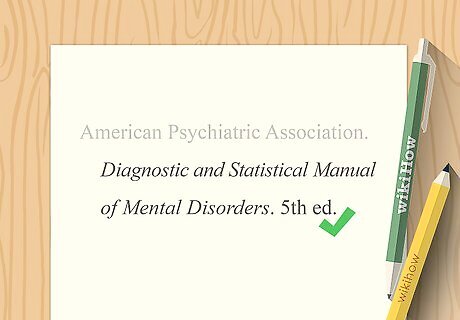
List the title of the manual and edition number. Type a space after the period following the author, then type the full title of the DSM-V in italics. Use title-style capitalization, capitalizing all the nouns in the title. Place a period after the title, then type the edition number without italics. Example: American Psychiatric Association. Diagnostic and Statistical Manual of Mental Disorders. 5th ed.
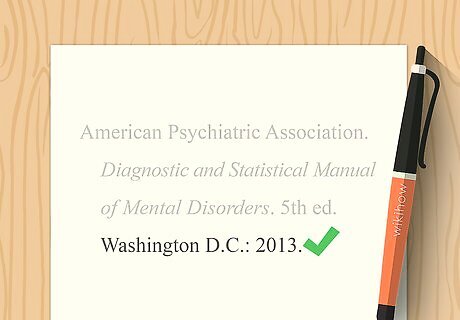
Provide publication information for the manual. After the title and edition number, type the location where the manual was published. Place a comma, then the name of the publisher. Follow the name of the publisher with a semi-colon, then type the year of publication. End your citation with a period. Example: American Psychiatric Association. Diagnostic and Statistical Manual of Mental Disorders. 5th ed. Washington D.C.: 2013.
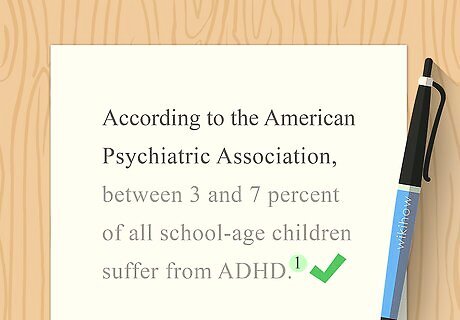
Use superscript numbers in-text to refer to your references. For AMA style, separate in-text citations are not used. Rather, your bibliography or list of references is numbered. Superscript numbers in your text refer to the specific number of the full citation. Example: According to the American Psychiatric Association, between 3 and 7 percent of all school-age children have ADHD. Generally, your reference list is ordered according to when the source is first mentioned or used in your text. The same superscript number is then used throughout your text to refer to the same source.




















Comments
0 comment